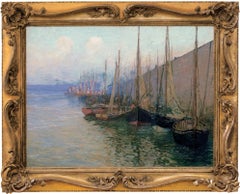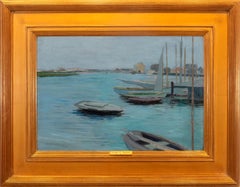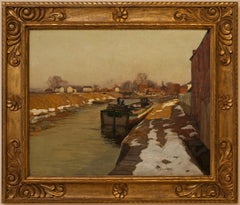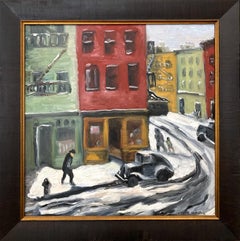Edward Willis Redfield Art
to
3
2
2
2
1
1
1
"In Port"
By Edward Willis Redfield
Located in Lambertville, NJ
Jim’s of Lambertville is proud to offer this artwork by:
Edward Willis Redfield (1869 - 1965)
Edward W. Redfield was born in Bridgeville, Delaware, moving to Philadelphia as a young child. Determined to be an artist from an early age, he studied at the Spring Garden Institute and the Franklin Institute before entering the Pennsylvania Academy from 1887 to 1889, where he studied under Thomas Anshutz, James Kelly, and Thomas Hovenden. Along with his friend and fellow artist, Robert Henri, he traveled abroad in 1889 and studied at the Academie Julian in Paris under William Bouguereau and Tony Robert-Fleury. While in France, Redfield met Elise Deligant, the daughter of an innkeeper, and married in London in 1893.
Upon his return to the United States, Redfield and his wife settled in Glenside, Pennsylvania. He remained there until 1898, at which time he moved his family to Center Bridge, a town several miles north of New Hope along the Delaware River. Redfield painted prolifically in the 1890s but it was not until the beginning of the twentieth century that he would develop the bold impressionist style that defined his career. As Redfield’s international reputation spread, many young artists gravitated to New Hope as he was a great inspiration and an iconic role model. Edward Redfield remained in Center Bridge throughout his long life, fathering his six children there.
Around 1905 and 1906, Redfield’s style was coming into its own, employing thick vigorous brush strokes tightly woven and layered with a multitude of colors. These large plein-air canvases define the essence of Pennsylvania Impressionism. By 1907, Redfield had perfected his craft and, from this point forward, was creating some of his finest work.
Redfield would once again return to France where he painted a small but important body of work between 1907 and 1908. While there, he received an Honorable Mention from the Paris Salon for one of these canvases. In 1910 he was awarded a Gold Medal at the prestigious Buenos Aires Exposition and at the Panama-Pacific Exposition of 1915 in San Francisco, an entire gallery was dedicated for twenty-one of his paintings.
Since Redfield painted for Exhibition with the intent to win medals, his best effort often went into his larger paintings. Although he also painted many fine smaller pictures, virtually all of his works were of major award-winning canvas sizes of 38x50 or 50x56 inches. If one were to assign a period of Redfield’s work that was representative of his “best period”, it would have to be from 1907 to 1925. Although he was capable of creating masterpieces though the late 1940s, his style fully matured by 1907 and most work from then through the early twenties was of consistently high quality. In the later 1920s and through the 1930s and 1940s, he was like most other great artists, creating some paintings that were superb examples and others that were of more ordinary quality.
Redfield earned an international reputation at a young age, known for accurately recording nature with his canvases and painting virtually all of his work outdoors; Redfield was one of a rare breed. He was regarded as the pioneer of impressionist winter landscape painting in America, having few if any equals. Redfield spent summers in Maine, first at Boothbay Harbor and beginning in the 1920s, on Monhegan Island. There he painted colorful marine and coastal scenes as well as the island’s landscape and fishing shacks. He remained active painting and making Windsor style furniture...
Category
Early 1900s American Impressionist Edward Willis Redfield Art
Materials
Canvas, Oil
"Sail Boats in Harbor"
By Edward Willis Redfield
Located in Lambertville, NJ
Jim’s of Lambertville is proud to offer this artwork by:
Edward Willis Redfield (1869 - 1965)
Edward W. Redfield was born in Bridgeville, Delaware, moving to Philadelphia as a youn...
Category
1890s American Impressionist Edward Willis Redfield Art
Materials
Canvas, Oil
"The Canal"
By Edward Willis Redfield
Located in Lambertville, NJ
Jim’s of Lambertville is proud to offer this artwork.
Signed lower left. Complemented by a hand carved and gilt frame.
Illustrated in "Edward Redfield: Just Values and Fine Seeing" by Constance Kimmerle and the Pennsylvania Academy of the Fine Arts's Exhibition of Paintings by Edward Redfield (April 17 to May 16, 1909) brochure
Edward Willis Redfield (1869 - 1965)
Edward W. Redfield was born in Bridgeville, Delaware, moving to Philadelphia as a young child. Determined to be an artist from an early age, he studied at the Spring Garden Institute and the Franklin Institute before entering the Pennsylvania Academy from 1887 to 1889, where he studied under Thomas Anshutz, James Kelly, and Thomas Hovenden. Along with his friend and fellow artist, Robert Henri, he traveled abroad in 1889 and studied at the Academie Julian in Paris under William Bouguereau and Tony Robert-Fleury. While in France, Redfield met Elise Deligant, the daughter of an innkeeper, and married in London in 1893.
Upon his return to the United States, Redfield and his wife settled in Glenside, Pennsylvania. He remained there until 1898, at which time he moved his family to Center Bridge, a town several miles north of New Hope along the Delaware River. Redfield painted prolifically in the 1890s but it was not until the beginning of the twentieth century that he would develop the bold impressionist style that defined his career. As Redfield’s international reputation spread, many young artists gravitated to New Hope as he was a great inspiration and an iconic role model. Edward Redfield remained in Center Bridge throughout his long life, fathering his six children there.
Around 1905 and 1906, Redfield’s style was coming into its own, employing thick vigorous brush strokes tightly woven and layered with a multitude of colors. These large plein-air canvases define the essence of Pennsylvania Impressionism. By 1907, Redfield had perfected his craft and, from this point forward, was creating some of his finest work.
Redfield would once again return to France where he painted a small but important body of work between 1907 and 1908. While there, he received an Honorable Mention from the Paris Salon for one of these canvases. In 1910 he was awarded a Gold Medal at the prestigious Buenos Aires Exposition and at the Panama-Pacific Exposition of 1915 in San Francisco, an entire gallery was dedicated for twenty-one of his paintings.
Since Redfield painted for Exhibition with the intent to win medals, his best effort often went into his larger paintings. Although he also painted many fine smaller pictures, virtually all of his works were of major award-winning canvas sizes of 38x50 or 50x56 inches. If one were to assign a period of Redfield’s work that was representative of his “best period”, it would have to be from 1907 to 1925. Although he was capable of creating masterpieces though the late 1940s, his style fully matured by 1907 and most work from then through the early twenties was of consistently high quality. In the later 1920s and through the 1930s and 1940s, he was like most other great artists, creating some paintings that were superb examples and others that were of more ordinary quality.
Redfield earned an international reputation at a young age, known for accurately recording nature with his canvases and painting virtually all of his work outdoors; Redfield was one of a rare breed. He was regarded as the pioneer of impressionist winter landscape painting in America, having few if any equals. Redfield spent summers in Maine, first at Boothbay Harbor and beginning in the 1920s, on Monhegan Island. There he painted colorful marine and coastal scenes as well as the island’s landscape and fishing shacks. He remained active painting and making Windsor style furniture...
Category
Early 1900s American Impressionist Edward Willis Redfield Art
Materials
Canvas, Oil
Related Items
Early 20th Century Pacific Coast Summer Landscape
By Margaret Wherry Ziegler
Located in Soquel, CA
Beautiful early 20th century plein air-style landscape by Margaret Wherry Ziegler (American, 1909-1989), c.1930. Trees, rocks, and meadow grass and flowers bask under a blue sky in this sunny summer landscape scene.
Signed and dated 1930 on verso stretcher bar.
Presented in a vintage wood frame.
Image size: 14.25"H x 12.25"W
Ziegler was born in Cincinnati, Ohio in 1909 At a young age she traveled with her parents to the Philippines, Japan, India, Italy, Greece, and Europe. She studied art at the Cincinnati Art Academy, Minneapolis Art Institute, the University of the Philippines, and the California College of Arts and Crafts. While in Japan she studied Japanese brush painting...
Category
Early 20th Century American Impressionist Edward Willis Redfield Art
Materials
Canvas, Oil
H 21 in W 19 in D 2 in
"Tavern Snow, West Village" Impressionistic Oil Painting in New York City 1920s
By Cindy Shaoul
Located in New York, NY
"With shades of Pierre Bonnard’s Parisian street vistas and Edward Hopper’s New York shopfronts, American impressionist Cindy Shaoul’s oil paintings depict the much-loved locales and...
Category
2010s American Impressionist Edward Willis Redfield Art
Materials
Oil, Canvas
Barn Beneath Mt. Tamalpais - Mid Century California Landscape
Located in Soquel, CA
Beautiful mid century California landscape painting of a red barn tucked in the hills beneath Mt. Tamalpais, by an unknown American artist. Signed "Bloomf...
Category
1950s American Impressionist Edward Willis Redfield Art
Materials
Canvas, Oil
H 25 in W 29 in D 2 in
Yellow Sky, Oil /Canvas, Rural Landscape, Colors, Architecture, Free Shipping
Located in Houston, TX
Look for FREE SHIPPING WHEN CHECKING OUT ON 1STDIBS
Spring Shade 20 x 16 OIL ON CANVAS FRAMED $2500 PAINTED 2022. Frame photo is only to show frame.
Artist Statement
Throughout my ...
Category
2010s American Impressionist Edward Willis Redfield Art
Materials
Oil, Canvas
Texas Pastoral Landscape with Bluebonnets
By Manuel Garza
Located in Austin, TX
A luminous, oil on canvas painting by Texas plain air painter Manuel Garza (American, B. 1940) measuring 24 by 36 inches. The painting depicts an idyllic nature scene set in Central Texas in the spring. The landscape features majestic oak trees, green mesquite bushes, prickly pear cacti, and fields of the Texas State flower: bluebonnets. The vast landscape expands into the distance beneath a blue sky with fluffy white cumulous clouds.
The painting is beautifully framed and ready to hang in a modern, brown wood and gold leaf frame measuring 42 by 30 inches.
Manuel Garza
(American, B. 1940)
Manuel Garza has made his vocation the painting of Central Texas Landscapes. Born in the Hill country, his parents were migrant farm workers. He traveled all over Texas and as far north as Michigan with his family, working along side them in the fields.
It was while picking cotton...
Category
Late 20th Century American Impressionist Edward Willis Redfield Art
Materials
Canvas, Oil
Vintage Coastal Pathway - Horizontal Landscape
Located in Soquel, CA
Tranquil horizontal landscape of a tree-lined pathway near the coast leading to a quaint cabin by an unknown artist (American, 20th Century). Uns...
Category
1980s American Impressionist Edward Willis Redfield Art
Materials
Oil, Cardboard, Canvas
Grey Day on the Bay
By Lu Haskew
Located in Loveland, CO
"Grey Day on the Bay" by Lu Haskew
Oil 24x28" framed, 16x20" image size
Signed lower left
When Lu visited her sister in Oregon she always made a point of visiting the ships at dock ...
Category
Early 2000s American Impressionist Edward Willis Redfield Art
Materials
Canvas, Oil
Crashing Waves and Rocks, California Coast, 1920s Seascape Marine Oil Painting
By Charles Partridge Adams
Located in Denver, CO
Vintage marine seascape oil painting of waves crashing on rocks along the California coast by Charles Partridge Adams (1858-1942). Colors include blue,...
Category
1920s American Impressionist Edward Willis Redfield Art
Materials
Oil, Canvas
H 10.25 in W 13.5 in D 0.75 in
Plowing the Fields, American Impressionist Landscape with Figure and Animal
By Henry McCarter
Located in Doylestown, PA
"Plowing the Fields" is an early 20th Century American Impressionist landscape by Pennsylvania Academy graduate and teacher Henry McCarter. The 20" x 24...
Category
Early 20th Century American Impressionist Edward Willis Redfield Art
Materials
Canvas, Oil
H 27.5 in W 31 in D 3 in
Creek, Painting by Leonard Rodowicz
Located in Long Island City, NY
An original oil on board painting measuring 11 x 14 inches by Polish/American artist Leonard Rodowicz, signed lower right.
Category
Mid-20th Century American Impressionist Edward Willis Redfield Art
Materials
Canvas, Oil
Cornwall, England
By Hayley Lever
Located in New York, NY
Signed and dated lower left: Hayley Lever / 1905
Category
20th Century American Impressionist Edward Willis Redfield Art
Materials
Canvas, Oil
Winter
Located in New York, NY
Signed and dated lower left: Kate H. Carpenter. / 1902
Category
20th Century American Impressionist Edward Willis Redfield Art
Materials
Oil, Canvas
Previously Available Items
Road to New Hope
By Edward Willis Redfield
Located in Lambertville, NJ
Ashley John is proud to offer this artwork by:
Edward Willis Redfield (1869 - 1965)
Edward W. Redfield was born in Bridgeville, Delaware, moving to Philadelphia as a young child. D...
Category
20th Century American Impressionist Edward Willis Redfield Art
Materials
Canvas, Oil
"The Road to the Mill"
By Edward Willis Redfield
Located in Lambertville, NJ
Signed lower right. Complemented by animi original period Newcomb Macklin frame.
Edward Willis Redfield (1869 - 1965)
Edward W. Redfield was born in Bridgeville, Delaware, moving...
Category
1920s American Impressionist Edward Willis Redfield Art
Materials
Canvas, Oil
"88 Club"
By Edward Willis Redfield
Located in Lambertville, NJ
Signed and titled lower center.
Complemented by a hand carved and gilt frame.
Edward Willis Redfield (1869 - 1965)
Edward W. Redfield was born in Bridgeville, Delaware, moving to Philadelphia as a young child. Determined to be an artist from an early age, he studied at the Spring Garden Institute and the Franklin Institute before entering the Pennsylvania Academy from 1887 to 1889, where he studied under Thomas Anshutz, James Kelly, and Thomas Hovenden. Along with his friend and fellow artist, Robert Henri, he traveled abroad in 1889 and studied at the Academie Julian in Paris under William Bouguereau and Tony Robert-Fleury. While in France, Redfield met Elise Deligant, the daughter of an innkeeper, and married in London in 1893.
Upon his return to the United States, Redfield and his wife settled in Glenside, Pennsylvania. He remained there until 1898, at which time he moved his family to Center Bridge, a town several miles north of New Hope along the Delaware River. Redfield painted prolifically in the 1890s but it was not until the beginning of the twentieth century that he would develop the bold impressionist style that defined his career. As Redfield’s international reputation spread, many young artists gravitated to New Hope as he was a great inspiration and an iconic role model. Edward Redfield remained in Center Bridge throughout his long life, fathering his six children there.
Around 1905 and 1906, Redfield’s style was coming into its own, employing thick vigorous brush strokes tightly woven and layered with a multitude of colors. These large plein-air canvases define the essence of Pennsylvania Impressionism. By 1907, Redfield had perfected his craft and, from this point forward, was creating some of his finest work.
Redfield would once again return to France where he painted a small but important body of work between 1907 and 1908. While there, he received an Honorable Mention from the Paris Salon for one of these canvases. In 1910 he was awarded a Gold Medal at the prestigious Buenos Aires Exposition and at the Panama-Pacific Exposition of 1915 in San Francisco, an entire gallery was dedicated for twenty-one of his paintings.
Since Redfield painted for Exhibition with the intent to win medals, his best effort often went into his larger paintings. Although he also painted many fine smaller pictures, virtually all of his works were of major award-winning canvas sizes of 38x50 or 50x56 inches. If one were to assign a period of Redfield’s work that was representative of his “best period”, it would have to be from 1907 to 1925. Although he was capable of creating masterpieces though the late 1940s, his style fully matured by 1907 and most work from then through the early twenties was of consistently high quality. In the later 1920s and through the 1930s and 1940s, he was like most other great artists, creating some paintings that were superb examples and others that were of more ordinary quality.
Redfield earned an international reputation at a young age, known for accurately recording nature with his canvases and painting virtually all of his work outdoors; Redfield was one of a rare breed. He was regarded as the pioneer of impressionist winter landscape painting in America, having few if any equals. Redfield spent summers in Maine, first at Boothbay Harbor and beginning in the 1920s, on Monhegan Island. There he painted colorful marine and coastal scenes as well as the island’s landscape and fishing shacks. He remained active painting and making Windsor style furniture...
Category
1950s American Impressionist Edward Willis Redfield Art
Materials
Paper, Ink
"Fisherman Beach, Monhegan"
By Edward Willis Redfield
Located in Lambertville, NJ
Signed and dated lower right.
Complemented by a hand carved and gilt frame.
Edward Willis Redfield (1869 - 1965)
Edward W. Redfield was born in Bridgeville, Delaware, moving to Philadelphia as a young child. Determined to be an artist from an early age, he studied at the Spring Garden Institute and the Franklin Institute before entering the Pennsylvania Academy from 1887 to 1889, where he studied under Thomas Anshutz, James Kelly, and Thomas Hovenden. Along with his friend and fellow artist, Robert Henri, he traveled abroad in 1889 and studied at the Academie Julian in Paris under William Bouguereau and Tony Robert-Fleury. While in France, Redfield met Elise Deligant, the daughter of an innkeeper, and married in London in 1893.
Upon his return to the United States, Redfield and his wife settled in Glenside, Pennsylvania. He remained there until 1898, at which time he moved his family to Center Bridge, a town several miles north of New Hope along the Delaware River. Redfield painted prolifically in the 1890s but it was not until the beginning of the twentieth century that he would develop the bold impressionist style that defined his career. As Redfield’s international reputation spread, many young artists gravitated to New Hope as he was a great inspiration and an iconic role model. Edward Redfield remained in Center Bridge throughout his long life, fathering his six children there.
Around 1905 and 1906, Redfield’s style was coming into its own, employing thick vigorous brush strokes tightly woven and layered with a multitude of colors. These large plein-air canvases define the essence of Pennsylvania Impressionism. By 1907, Redfield had perfected his craft and, from this point forward, was creating some of his finest work.
Redfield would once again return to France where he painted a small but important body of work between 1907 and 1908. While there, he received an Honorable Mention from the Paris Salon for one of these canvases. In 1910 he was awarded a Gold Medal at the prestigious Buenos Aires Exposition and at the Panama-Pacific Exposition of 1915 in San Francisco, an entire gallery was dedicated for twenty-one of his paintings.
Since Redfield painted for Exhibition with the intent to win medals, his best effort often went into his larger paintings. Although he also painted many fine smaller pictures, virtually all of his works were of major award-winning canvas sizes of 38x50 or 50x56 inches. If one were to assign a period of Redfield’s work that was representative of his “best period”, it would have to be from 1907 to 1925. Although he was capable of creating masterpieces though the late 1940s, his style fully matured by 1907 and most work from then through the early twenties was of consistently high quality. In the later 1920s and through the 1930s and 1940s, he was like most other great artists, creating some paintings that were superb examples and others that were of more ordinary quality.
Redfield earned an international reputation at a young age, known for accurately recording nature with his canvases and painting virtually all of his work outdoors; Redfield was one of a rare breed. He was regarded as the pioneer of impressionist winter landscape painting in America, having few if any equals. Redfield spent summers in Maine, first at Boothbay Harbor and beginning in the 1920s, on Monhegan Island. There he painted colorful marine and coastal scenes as well as the island’s landscape and fishing shacks. He remained active painting and making Windsor style furniture...
Category
1920s American Impressionist Edward Willis Redfield Art
Materials
Canvas, Oil
"Winter Sports"
By Edward Willis Redfield
Located in Lambertville, NJ
Signed Lower Left
Period Newcomb Macklin Frame
Edward W. Redfield was born in Bridgeville, Delaware, moving to Philadelphia as a young child. Determined to be an artist from a...
Category
20th Century American Impressionist Edward Willis Redfield Art
Materials
Canvas, Oil
Lumberville
By Edward Willis Redfield
Located in Lambertville, NJ
Winter village sleigh Landscape town snow
Category
20th Century Edward Willis Redfield Art
Materials
Canvas, Oil
Early Morning Sunlight, Spring
By Edward Willis Redfield
Located in Lambertville, NJ
Category
20th Century Edward Willis Redfield Art
Materials
Canvas, Oil
Edward Willis Redfield art for sale on 1stDibs.
Find a wide variety of authentic Edward Willis Redfield art available for sale on 1stDibs. You can also browse by medium to find art by Edward Willis Redfield in canvas, fabric, oil paint and more. Much of the original work by this artist or collective was created during the early 1900s and is mostly associated with the Impressionist style. Not every interior allows for large Edward Willis Redfield art, so small editions measuring 37 inches across are available. Customers who are interested in this artist might also find the work of Edward Henry Potthast, Irving Ramsey Wiles, and Henry Bacon. Edward Willis Redfield art prices can differ depending upon medium, time period and other attributes. On 1stDibs, the price for these items starts at $61,875 and tops out at $781,250, while the average work can sell for $531,250.






